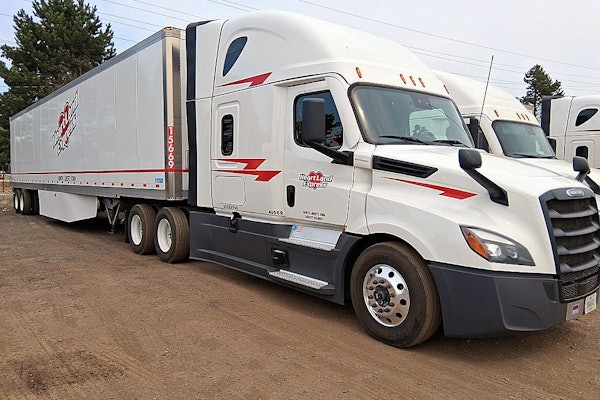Joel Morrow is known far and wide not only for for his passion for fuel efficiency, but the results that he gets. This newest VNL 860 sleeper – Purple Haze 2 – festures Volvo's I-Torque spec with D13 Turbo Compound engine equipped with a 500 hp/1,950 lb-ft. rating.
Morrow, chief executive officer for Alpha Drivers Testing & Consulting, gives CCJ Editor Jason Cannon the low-down on his ultra-efficient tractor and how his routinely reaches previously unheard of fuel economy.
In this video
00:00 – 11 MPG in a Class 8 Truck
00:35 – Powertrain
01:40 – Lift Axles and Suspension
03:30 – Time and Speed
04:35 – 12 MPG?
05:11 – Advice for Smaller Fleets
00;00;00;00 - 00;00;08;28
Jason Cannon
The average class eight truck gets less than six miles per gallon. Joe Morrow gets 11 fully loaded. Joe, tell us about this purple truck right here.
00;00;09;00 - 00;00;23;21
Joel Morrow
This is Purple Haze two. It's the latest generation Vnl. It is the I talk spec, which is aggressively down speed. It is a 519 50 D13 TC, and this is an 11 mile a gallon truck.
00;00;23;23 - 00;00;36;17
Jason Cannon
Hi, I'm CCJ editor Jason Cannon, and in this video I'm talking with Joel to learn how he gets such impressive fuel economy. And for more fuel efficiency tips and trucking industry news, sign up for our newsletter using the link below.
00;00;36;19 - 00;00;57;09
Joel Morrow
So it used to be that everything was absolutely speed related, and in order to achieve that type of fuel efficiency, you were driving 55 miles an hour. It's just the way it was with today's advanced aerodynamics. And you can see how slippery this truck is. We have the ultra low rolling resistance Michelin rubber on this, which absolutely helps.
00;00;57;09 - 00;00;59;24
Joel Morrow
And then the down speed powertrain.
00;01;00;02 - 00;01;13;11
Jason Cannon
This down speed powertrain, also known as all those, torque system, combines the D13, TC engine, shift transmission with adaptive gear shifting and low rear axle ratios to achieve high torque at low rpm.
00;01;13;16 - 00;01;23;27
Joel Morrow
And so at 65 miles an hour, we're running about 900 rpm. And it'll it'll huff 80,000 pounds right down the road with no problem at 900 rpm.
00;01;23;27 - 00;01;34;13
Jason Cannon
Lower rpms alone don't guarantee greater fuel efficiency, but Volvo's torque system keeps the Vnl in its optimal RPM range even at higher speeds, which maximizes fuel efficiency.
00;01;34;14 - 00;01;43;10
Joel Morrow
So we're achieving that 11 miles a gallon at a much higher speed, even with heavier weight. So you've got to lift axle.
00;01;43;12 - 00;01;45;09
Jason Cannon
When do you raise it? When do you lower it? How does it work.
00;01;45;13 - 00;02;08;10
Joel Morrow
So that the truck knows it? It figures out, okay, I'm legal to lift the axle. We also have to lift the axle on the trailer on this particular truck. Generally, if I'm under 15,000 pounds in the trailer, I'm going to have two axles up. Even if you're loaded all the time, to the point where you can't get them off the ground with the payload going to get those loads, you can really help drive your fuel efficiency up, Joel says.
00;02;08;10 - 00;02;15;21
Jason Cannon
The key to the truck's lift axle performance lies in its midship placement. Combined with a high capacity front axle and weight biasing suspension.
00;02;15;21 - 00;02;41;19
Joel Morrow
We have a high capacity front axle. This is a 14,600 pound rated steer axle, and we have to have that high rating because I have a weight biasing suspension with a lift axle midship, and that means that we optimize the weight that goes to the steer axle and the drive axle. When we optimize weight up front, it improves ride, it improves handling, especially when it's wet or in the snow.
00;02;41;19 - 00;02;59;15
Joel Morrow
So we go midship here and this is the lift axle. And obviously you can see it's off the ground right now. This is kind of the the secret sauce to the whole six by two concept. In the past we always had a dead axle, six by two, where the drive axle was actually in the front, the dead axle was in the back and it didn't lift off the ground.
00;02;59;17 - 00;03;18;18
Joel Morrow
And that created all kinds of traction issues and handling issues. This has tractive potential on par with a six by four, with significantly better fuel efficiency. I typically see about a half mile a gallon increase in fuel efficiency with this axle arrangement versus the standard six by four.
00;03;18;26 - 00;03;38;15
Jason Cannon
And when the lift axle on the trailer is raised, two Joel says he gains another three quarters of a mile per gallon, bringing the total fuel savings to roughly 1.25 miles per gallon. When both axles are off the ground. Beyond the truck's technology, a large part of Joel's strategy is time and speed management. So the internet's full of skeptics.
00;03;38;15 - 00;03;40;03
Jason Cannon
They see all these numbers and they say.
00;03;40;03 - 00;03;40;17
Joel Morrow
Joel.
00;03;40;20 - 00;03;45;01
Jason Cannon
You're never you never drive anywhere. You never haul anything. What's an average week look like for you?
00;03;45;09 - 00;04;07;10
Joel Morrow
So I'm downhill both ways. Not right. Yeah. That's that's always you know that's this is what we're here and you're only driving 45 mile an hour and which neither are true. So we're running general freight off the load board, just like most owner operators are. Nothing is really cherry picked. And we're we're hoping that down the highway, a lot of times when we can drive 58, we'll drive 58.
00;04;07;11 - 00;04;26;03
Joel Morrow
When we have to drive 72 will drive 72. We do manage our speed and time. We just don't set the cruise at 72 everywhere we go for the sake of running 72 when it makes sense to run slower. We run slower. When it makes sense to run faster, we do that and we make that decision based on each individual load.
00;04;26;06 - 00;04;37;03
Joel Morrow
There's no magic number on speed and that's why we have the gearing in this truck. So when I have to run 72, at least I can do it efficiently.
00;04;37;05 - 00;04;45;21
Jason Cannon
Joe is still looking to increase his fuel mileage, and his main strategy for improvement is further lowering his rear axle ratio, which currently sits at 216.
00;04;45;28 - 00;05;03;28
Joel Morrow
I think I'm going to push that rear axle ratio down to 205, and I think that 205 not only is the engine going to turn 35 or 40 less rpm than the 216, but it's going to enable us to pick up some more of that kinetic energy, that free money. Why we're going down the road where the truck will roll.
00;05;04;01 - 00;05;11;12
Joel Morrow
Best guess I'm thinking we're looking at 3/10 to a half mile a gallon better than what this is going to top out at on the next version.
00;05;11;15 - 00;05;17;22
Jason Cannon
For smaller carriers looking to boost their fuel efficiency without buying the latest tech, Joe has some simple advice.
00;05;17;25 - 00;05;37;12
Joel Morrow
So many guys, especially the owner operators that are out here for the lifestyle, they don't necessarily see it as a business. When you see this as a business, you start to understand how important it is to manage your speed and your time and do what's appropriate for the situation. Understand this is a business and be open minded, willing to do what's right for your business.











